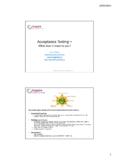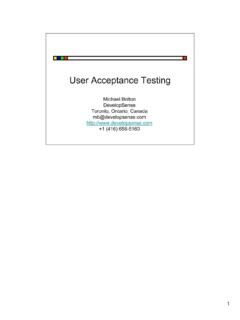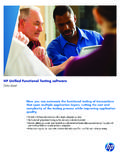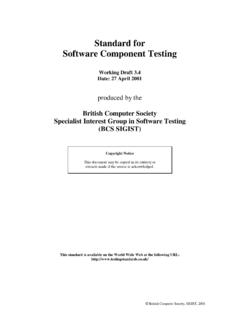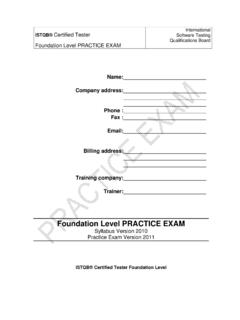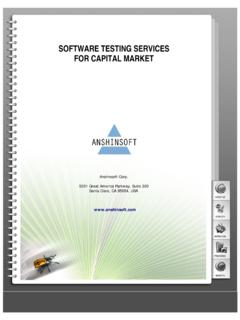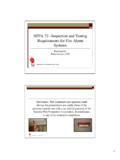Transcription of Factory Acceptance Testing Guideline - RISE
1 Factory Acceptance Testing Process Industry Guideline IEC 61511. Version: Last Edited:2006-08-25. Factory Acceptance Testing Guideline Comments on this report are gratefully received by Johan Hedberg at SP Swedish National Testing and Research Institute -1- Factory Acceptance Testing Process Industry Guideline IEC 61511. Version: Last Edited:2006-08-25. Summary According to the standard IEC 61551 the Factory Acceptance test (FAT) is not a requirement but is necessary to carry out if the application software of the logic solver is complex or if the architecture is using redundant arrangements. The general questions in the planning phase of the FAT concern the tests to be performed and how to deal with the tests.
2 The FAT is a practical way to test and verify the correct operation of the safety instrumented system. -2- Factory Acceptance Testing Process Industry Guideline IEC 61511. Version: Last Edited:2006-08-25. Table of contents 1. Introduction .. 4. 4. 4. 4. 2. Definitions and 4. 3. Factory Acceptance test (FAT).. 6. Planning .. 6. Test activities .. 7. Test 8. Checklist .. 9. FAT specification form .. 11. -3- Factory Acceptance Testing Process Industry Guideline IEC 61511. Version: Last Edited:2006-08-25. 1. Introduction Purpose The aim of this document is to try to describe the requirements concerning Factory Acceptance Testing , FAT, according to the standard IEC 61511.
3 The FAT is a customized Testing procedure for different types of systems and the tests are executed before the final installation at the plant. The FAT is not a requirement but recommended to be carried out, according to the standard IEC 61511, if the application software of the logic solver is fairly complex or if the architecture of the safety instrumented system is using redundant arrangements. In many cases it is difficult to predict the correct operation of the safety instrumented system or consequences due to failures in some parts of the safety instrumented system. For that reason the FAT is a valuable check of the safety issues.
4 The test cases are selected during the planning phase in order to test the safety measures as far as possible. References [1] IEC 61511-1 Functional safety- Safety instrumented systems for the process industry sector, Part 1: Framework, definitions, system, hardware and software requirements [2] IEC 61511-2 Functional safety- Safety instrumented systems for the process industry sector- Part 2: Guidelines for the application of IEC 61511-1. [3] IEC 61511-3 Functional safety- Safety instrumented systems for the process industry sector- Part 3: Guidance for the determination of the required safety integrity level Scope This document covers the parts in IEC 61511 concerning the FAT.
5 The FAT can be used as an integration test or during validation of the safety instrumented system. 2. Definitions and abbreviations basic process control system (BPCS). system which responds to input signals from the process, its associated equipment, other programmable systems and/or an operator and generates output signals causing the process and its associated equipment to operate in the desired manner but which does not perform any safety instrumented functions with a claimed SIL 1 ( in IEC 61511-1). fault abnormal condition that may cause a reduction in, or loss of, the capability of a functional unit to perform a required function ( in IEC 61511-1).
6 Failure termination of the ability of a functional unit to perform a required function ( in IEC 61511-1). error discrepancy between a computed, observed or measured value or condition and the true, specified or theoretically correct value or condition ( in IEC 61511-1). hazard -4- Factory Acceptance Testing Process Industry Guideline IEC 61511. Version: Last Edited:2006-08-25. potential source of harm ( in IEC 61511-1). hazardous situation circumstance in which a person is exposed to hazard(s) ( in IEC 61508-4). hazardous event hazardous situation which results in harm ( in IEC 61508-4). harm physical injury or damage to the health of people, either directly or indirectly, as a result of damage to property or to the environment ( in IEC 61511-1).
7 Instrument apparatus used in performing an action (typically found in instrumented systems) ( in IEC. 61511-1). NOTE Instrumented systems in the process sector are typically composed of sensors (for example, pressure, flow, temperature transmitters), logic solvers or control systems (for example, programmable controllers, distributed control systems), and final elements (for example, control valves). In special cases, instrumented systems can be safety instrumented systems (see in IEC 61511-1). process risk risk arising from the process conditions caused by abnormal events (including BPCS. malfunction). NOTE 1 The risk in this context is that associated with the specific hazardous event in which SIS are to be used to provide the necessary risk reduction ( , the risk associated with functional safety).
8 ( in IEC 61511-1). safety instrumented function (SIF). safety function with a specified safety integrity level which is necessary to achieve functional safety and which can be either a safety instrumented protection function or a safety instrumented control function ( in IEC 61511-1). -5- Factory Acceptance Testing Process Industry Guideline IEC 61511. Version: Last Edited:2006-08-25. 3. Factory Acceptance test (FAT). The main objective of the FAT is to test the safety instrumented system (logic solver and associated software together). The tests are normally executed during the final part of the design and engineering phase before the final installation at the plant.
9 The FAT is a customized procedure of checking the safety instrumented system and the safety instrumented functions according to the safety requirements specification, see figure 1. Figure 1. Factory Acceptance Testing The FAT includes appropriate general Testing procedures for verification of the correct operation of the safety instrumented system. Since the Testing activities are general methods the FAT is applicable to programmable or non programmable safety instrumented systems. The most important part of the FAT addresses specification of the test cases clear description of the test cases, well structured test procedures and relevant test cases.
10 Planning The planning presents a set op of the appropriate tests to be carried out and who is responsible for developing the test cases. Appropriate levels of competence and independence of assessors are required. The realization of tests shall be described as well as the personnel responsible to carry out the test. The test protocol is developed during the planning and furthermore who is responsible to attest the test protocol. The procedures to carry out the FAT shall be well defined and documented in a proper way. Each test procedure shall be described in a logical sequence how to test the application software and hardware.
